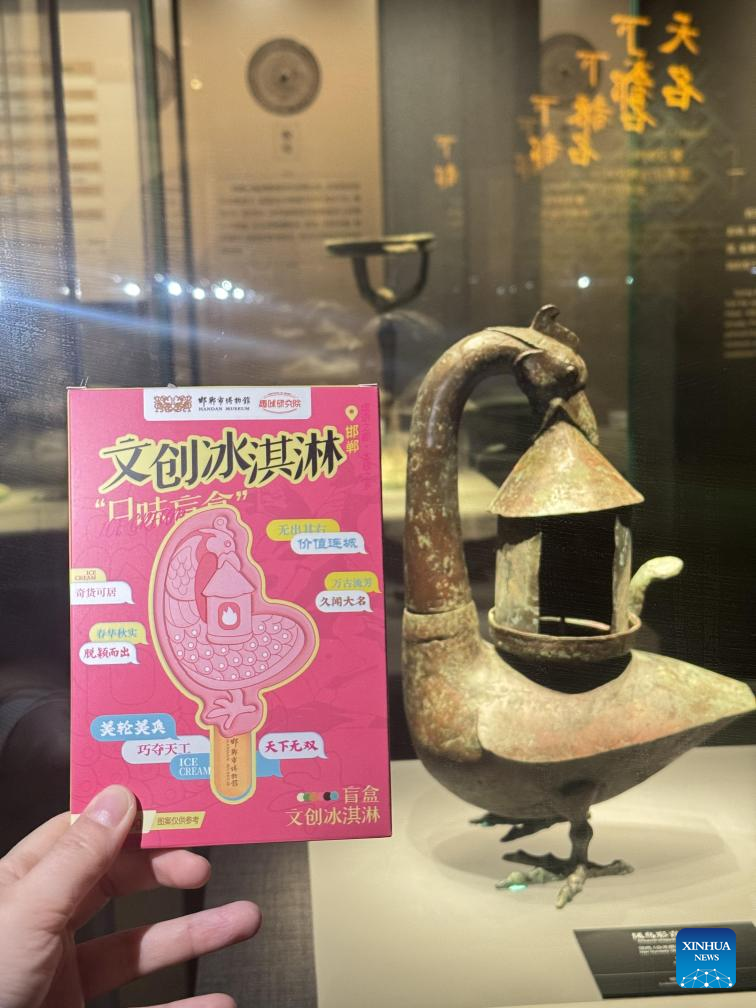China Focus: China's upscale ice creams melting hearts of consumers
Source: Xinhua
Editor: huaxia
2025-08-16 16:06:15

This photo taken on April 2, 2025 shows a "blind box" containing a randomly flavored ice cream introduced by Handan Museum in Handan, north China's Hebei Province. (Photo by Wang Haiyun/Xinhua)
by Xinhua writers Huang Yuzhang, Dong Xiaokun, Bai Lin
SHIJIAZHUANG, Aug. 16 (Xinhua) -- Once just a simple way to cool off, ice cream is seeing a surge of new varieties to meet the expanding tastes and preferences of Chinese consumers.
Pan Yang, 17, recently took pictures of a matcha-flavored ice cream she had bought at a shopping mall in Shijiazhuang, the capital city of north China's Hebei Province. "I bought this one because it looked so attractive," she said. "There were even petals strewn over it."
On the Chinese lifestyle-sharing app known internationally as rednote, many users have posted appealing images of upscale ice creams in various shapes, ranging from blooming flowers to fresh fruits, each of which is the result of delicate craftsmanship. Comments such as "adorable" and "too pretty to eat" abound in these posts.
Favored by today's consumers, especially young people, such ice creams have become commonplace in souvenir shops at tourist attractions across China.
Handan Museum, a well-known tourist site in Hebei, in April introduced creative ice creams that draw inspiration from two precious artifacts housed in the museum. "Blind boxes" containing randomly flavored ice creams are also on sale to attract customers.
The museum's ice creams have been a hit among visitors since their launch, with over 100 sold daily this summer, said Wang Haiyun, who works at the museum. "We hope people of different ages can savor both delicious tastes and local culture through our ice creams."
Food industry analyst Zhu Danpeng believes the emergence of these visually appealing ice creams reflects a thirst for emotional and spiritual well-being in consumption.
"Young Chinese people attach importance to the social aspects of goods and the emotional value they can offer, which drives the entire industry to innovate its offerings for consumers to enjoy fresh, pleasant experiences," Zhu said.
While seeking visual and emotional delight from these frozen treats, Chinese consumers are also placing increased emphasis on the quality of ice cream as living standards and health consciousness rise.
A 23-year-old ice cream fan, surnamed Dong, told Xinhua that a high-quality ice cream should be both delicious and healthy. "If two ice creams share similar tastes, I will choose the one with a cleaner ingredient list," she said.
Many more consumers are also making this choice. The results of a 2024 survey from iiMedia Research show that nearly half of all respondents would consider "taste" in their consumption of ice cream, which topped the list of important factors, and those who opted for "health and low fat" and "ingredient list" factors made up 33.08 percent and 30.25 percent of respondents.
The shift to healthy eating has spurred changes in the industry. Traditional ice cream makers are adjusting their ingredients and unveiling new products in response to evolving needs, while new brands are gaining traction by labeling themselves as producers of handcrafted and freshly made ice creams.
Romanlin Ice Cream is one such emerging brand. Founded in 2019, the Hebei-based company has opened more than 500 stores in China, and has also launched business in Malaysia, according to Ma Zhichao, chairman of the company.
"Good-looking products can draw first-time consumers, while good-tasting products will attract them to buy again," Ma said, adding that to date, the brand boasts more than 30 ice cream flavors attuned to the tastes of Chinese consumers and has rolled out specialized products in different localities.
To strike a balance between taste and health, Ma stressed the importance of ingredients and equipment in ice cream production.
"High sugar and fat were once necessary to achieve a creamy and velvety texture, but premium ingredients and advanced equipment can help us deliver a nice mouthfeel with reduced levels," he explained.
But this gives rise to another question: Compared to traditional makers, these new brands tend to be more expensive, so will they deter potential buyers?
According to brand-positioning expert Zhan Junhao, value for money has become a key criterion for China's maturing consumers. "If the innovation and quality justify the price, people are still willing to pay," he said.
Dong was of the same view during her interview. "I'll pay more for ice cream with top-notch ingredients, but if the quality isn't there? No Way!" she said. ■



